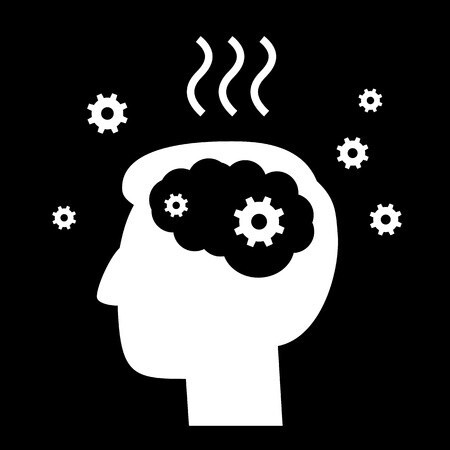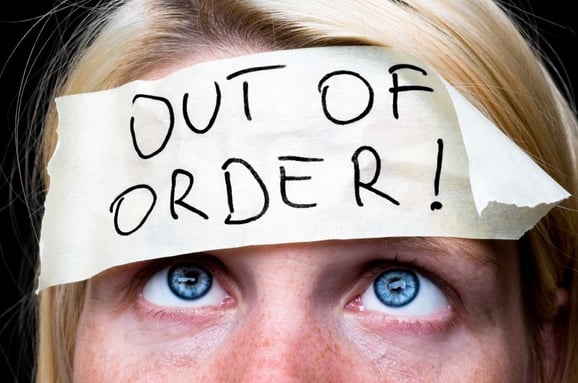
WHEN WAS THE LAST TIME you saw someone freaking out because they were completely in control of their work? I’m going to take a wild guess: never. Feeling that you have control over demands means that the demands are no longer a threat, and, as a result, they can’t turn on your ancient defense equipment, the stress response.
Control is the difference between managing work and life pressures and being at the frayed mercy of them. It’s a critical distinction in an unbounded world of devices and distractions, where so many things are intruding into working memories and limited bandwidths that it seems we have no control over anything. As the unmanaged email and interruption count skyrockets, so does overwhelm, which explodes when there are more demands than we think we can keep up with.
THE FUEL OF JOB STRESS
When things are out of control, you can bet stress and work-life balance are too. Work-life balance is itself an exercise in control, trying to ensure that both work and home responsibilities are being handled.
Researcher Robert Karasek of the University of Massachusetts identified the central mechanism in work stress as the level of demands versus the amount of control over them. The more decision “latitude” you have, the ability to affect the work you do and how you do it, the less stress. High demands and low control add up to high stress. High demands and high control, though, mean the work is manageable, even enjoyable as a challenge.
Karasek’s job strain model demonstrated that employees with the least decision-making options had more exhaustion, depression and sleep issues. These unhealthy impacts of little latitude have been vetted by scads of research over the years, including the landmark British Whitehall Studies, I and II, which examined some 28,000 civil servants altogether. Those investigations found a clear connection between stress and the position of the person in the organization hierarchy. The lowest ranking people, who had the least decision-making discretion, had a mortality rate three times higher than administrators.
Interestingly enough, this dichotomy is also what Stanford University scientist Robert Sapolsky found in his research with apes. Those on the bottom of the social totem pole were the most stressed and least healthy. Helplessness is stressful, and in humans it leads to a downward spiral of pessimism and depression.
LATITUDE ADJUSTMENT
Having the ability to control the work environment makes a massive difference in how brains process demands. When we can’t do anything about job demands mental strain develops. That in turn can set off the body’s defense equipment, since you aren’t able to take actions to cope with the demands. Not being able to mitigate a demand that is perceived as a threat is the definition of stress—and a fight-or-flight trigger.
Control isn’t just key to managing demands, it’s also the essential element of attention, performance, and doing the tasks that need to be done. It’s a managing partner with self-regulation in discipline and willpower to keep you focused on task. Stress undermines intellect and constricts the brain to perceived crises and rumination in tenses other than the one you’re trying to work in, which shreds focus and concentration. The same is true of missing work-life balance, the lack of which is an ongoing source of concern and guilt, taking minds far afield when home issues aren’t being handled.
Obviously, we can’t all be control freaks on the job. We are there to do what others want, but that doesn’t mean there can’t be more flexibility in how individuals choose to do and think about the practices they are tasked with and how managers frame the tasks to be done. This is the dynamic behind autonomy support, one of the most effective systems for increasing employee engagement, when people willingly put forth extra effort. It’s based on tapping into core human needs such as autonomy and competence, which bolster perception of self-control by increasing employee involvement and responsibility.
Getting more control over your work-life is a matter of taking many practical steps to better organize, plan, and manage an unbounded world. It comes down to something that all humans are primed to do for their own safety and well-being—make life more predictable. Threats are manageable when we have wrestled them into more predictable paths and outcomes. I’m not saying you have to be a psychic, but you do have to take steps to harness the bucking broncos in your life and minimize the possibility of being thrown.
Here are a few steps that can help you feel more control:
1. Control Email and Devices. If you have your email on autopilot, with incoming every five minutes, that’s a potential of 96 interruptions over the course of the day. Unbounded email is a great way to drive overwhelm. Check your email at designated times. Three and four times a day is the most productive, say U. C. Irvine and Oklahoma State researchers. Keep your email and phone turned off and check them manually when you decide, not the startle response set off by device noisemakers.
2. Interruption Management. Disable the visual alerts on your screen. Set aside times, 30 minutes here, an hour there, for no-interruption zones. Put a message on your autoresponder that you’re on a deadline. Researchers say that when you’re being interrupted, it makes anything you’re doing seem more difficult, i. e., out of control, than it actually is.
3. Stop Multitasking. Circus clowns can juggle bowling pins, but you can’t do more than one cognitive task at a time. There’s only one neural channel for language to go through. You are not talking on the phone and doing email at the same time. You are switching back and forth. In that switching there’s a cost: stress, as brain neurons try to figure out where they were before they jumped to the secondary task.
4. Ask for a Rationale. Studies show that when we ask for a rationale for doing a task or give one to someone we’re asking to do something, the task gets internalized, and it becomes something more important and makes us feel we are exercising choice, autonomy, latitude. This undercuts hierarchy and order-taking strain.
5. Time Estimation. Take time and figure out how long it takes you to do each of your primary tasks. When you are asked to do one of them, you then have a hard time estimate, instead of wishful optimism, about how long it’s going to take to do it.
And finally, Karasek pinpointed demands that drive low control and strain—time pressure, reaction time needed, pacing, amount of work, having to wait for others to do their part of the task, interruptions, and concentration needed. How could you and your team adjust these demands to make them more manageable?
Propose alternative ways of doing a task that would allow you to feel it’s more manageable. Studies show that speaking up doesn't have the whammy we think. It’s how everyone finds out what isn’t working, in other words, what’s out of control.
If you would like to train your team in effective work practices, reduce stress, and increase productivity, click the button below for details on our time management training, stress management training, and work-life balance programs.






















